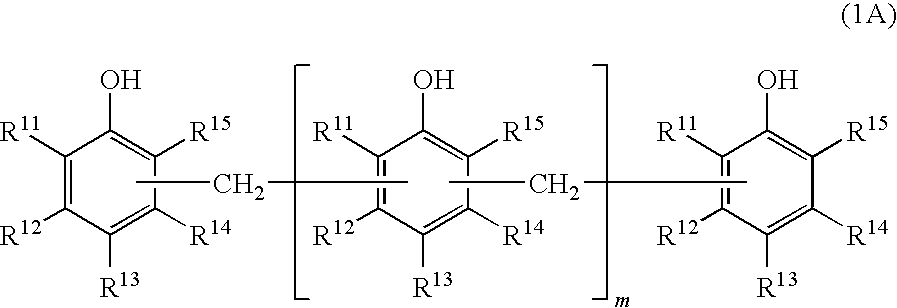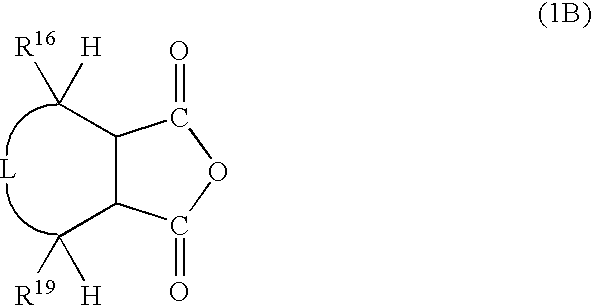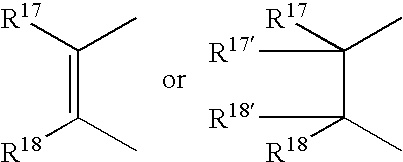Resin composition and semiconductor device empolying the same
- Summary
- Abstract
- Description
- Claims
- Application Information
AI Technical Summary
Benefits of technology
Problems solved by technology
Method used
Image
Examples
example 1
Preparation of Resin Composition
[0078]In a multipurpose mixer (2DMV-R™, available from Dalton Co., Ltd.), 12.73 wt. % of Epoxy a-1, 3.14 wt. % of Phenol b-A1, 0.5 wt. % of Epoxy silane and Silica-1 were placed and mixed at 80° C. for 2 hours while the mixing chamber was being evacuated. Thereafter, the temperature was brought down to 60° C., and then a solution in which 1 wt. % of Catalyst A-1 and 0.5 wt. % of Catalyst B-1 were dissolved in 3 wt. % phenol was added and mixed for 10 minutes to obtain a resin composition. In the above, Silica-1 was added in the residual amount, which corresponded to the difference between the weight of the resultant composition and the total weight of the other components. The obtained composition could be supplied from a dispenser, and was found to be excellent in storage stability. It was also found that the adhesion strength of the composition to copper was 830 kPa after the PCT and reflow treatment.
examples 10 to 13
[0084]The procedure of Example 1 was repeated, except that the ratio of Catalysts A-1 and B-1 was changed into those shown in Table 2, to prepare resin compositions. With respect to each prepared composition, it was evaluated how much adhesion strength to copper the composition had after the PCT and reflow treatment, whether the composition could be molded, whether the composition could be supplied from a dispenser and whether the composition had satisfying storage stability. The results were shown in Table 2 together with those of Example 1 and Comparative Examples 4 and 6.
TABLE 2Com.ExamplesCom.41011112136Epoxy a-112.7312.7312.7312.7312.7312.7312.73Phenol b-A16.146.146.146.146.146.146.14Epoxy silane0.50.50.50.50.50.50.5Catalyst A-11.51.351.12510.750.6Catalyst B-10.150.3750.50.750.91.5Silica-1residueresidueresidueresidueresidueresidueresidueAdhesion strength—13201190830660510250after PCT and reflow[kPa]MoldingfailurepossiblepossiblepossiblepossiblepossiblepossibleSupplying from dis...
examples 14 to 16
[0086]The procedure of Example 1 was repeated, except that the total amount of Catalysts A-1 and B-1 was changed into those shown in Table 3, to prepare resin compositions. With respect to each prepared composition, it was evaluated how much adhesion strength to copper the composition had after the PCT and reflow treatment, whether the composition could be molded, whether the composition could be supplied from a dispenser and whether the composition had satisfying storage stability. The results were shown in Table 3 together with that of Example 1.
TABLE 3Examples1415116Epoxy a-112.7312.7312.7312.73Phenol b-A16.146.146.146.14Epoxy silane0.50.50.50.5Catalyst A-10.330.6711.33Catalyst B-10.170.330.50.67Silica-1residueresidueresidueresidueAdhesion strength8008508301570after PCT and reflow[kPa]MoldingpossiblepossiblepossiblepossibleSupplying from dispenserpossiblepossiblepossiblepossibleStorage stabilitygoodgoodgoodgood
[0087]The above results indicated that, if the total amount of the cat...
PUM
| Property | Measurement | Unit |
|---|---|---|
| Temperature | aaaaa | aaaaa |
| Temperature | aaaaa | aaaaa |
| Time | aaaaa | aaaaa |
Abstract
Description
Claims
Application Information
 Login to View More
Login to View More - R&D Engineer
- R&D Manager
- IP Professional
- Industry Leading Data Capabilities
- Powerful AI technology
- Patent DNA Extraction
Browse by: Latest US Patents, China's latest patents, Technical Efficacy Thesaurus, Application Domain, Technology Topic, Popular Technical Reports.
© 2024 PatSnap. All rights reserved.Legal|Privacy policy|Modern Slavery Act Transparency Statement|Sitemap|About US| Contact US: help@patsnap.com










